Vertical MXene array without dendrite high rate lithium storage
QQ Academic Group: 1092348845
Detailed
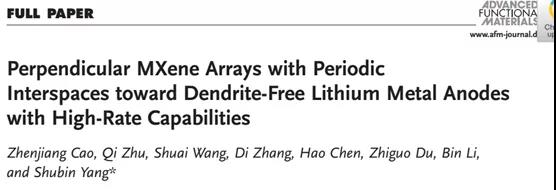
【Research Background】
Lithium metal anodes have been widely used in lithium-based batteries due to their high capacity and low electrochemical potential. However, due to poor chemical stability, the lithium metal negative electrode inevitably generates lithium dendrites during deep insertion and deintercalation, consuming a large amount of electrolyte, resulting in accumulation of heat and pressure, posing a serious safety hazard. In addition, during reversible deep intercalation and deintercalation, lithium negative electrodes are often limited by volume changes, resulting in short cycle life. In order to overcome the problems of lithium dendrite and volume change, some strategies including 3D host (foam nickel, graphene oxide foam, etc.) have been successfully developed. The 3D host can significantly promote the transfer of lithium ions or electrons, greatly improve cycle life, and inhibit volume changes during reversible embedding and deintercalation. However, for 3D hosts, their pores are usually disordered. Recently, some host materials with periodic and uniform pores and channels have been developed. These periodic upright structures not only facilitate the rapid transfer of lithium ions and electrons, but also provide a rich internal space for the intercalation and deintercalation of lithium ions. Therefore, the application of these vertically aligned hosts to lithium-based batteries will result in improved high rate capabilities.
[Introduction]
Recently, Professor Yang Shubin from the Beijing University of Aeronautics and Astronautics published a research paper entitled "Perpendicular MXene Arrays with Periodic Interspaces toward Dendrite-Free Lithium Metal Anodes with High-Rate Capabilities" in the internationally renowned academic journal Advanced Functional Materials. A unique vertical MXene-Li array with two periodic intervals, a nanoscale gap in the MXene wall by a simple hobbing method and a micron-scale gap between the MXene walls . This well-designed structure effectively reduces the lightning rod effect during lithium insertion and deintercalation, allowing lithium to be deposited evenly inside the MXene array. Combined with the function of homogenization of lithium flux and electric field strength, a dendritic lithium anode is realized on the basis of a vertical MXene-Li array. When a vertical MXene-Li array is used as the negative electrode of a lithium metal battery, a low potential of 25 mV, a high capacity of 2056 mAh g-1, and good cycle stability of up to 1700 h can be obtained.
[Graphic introduction]
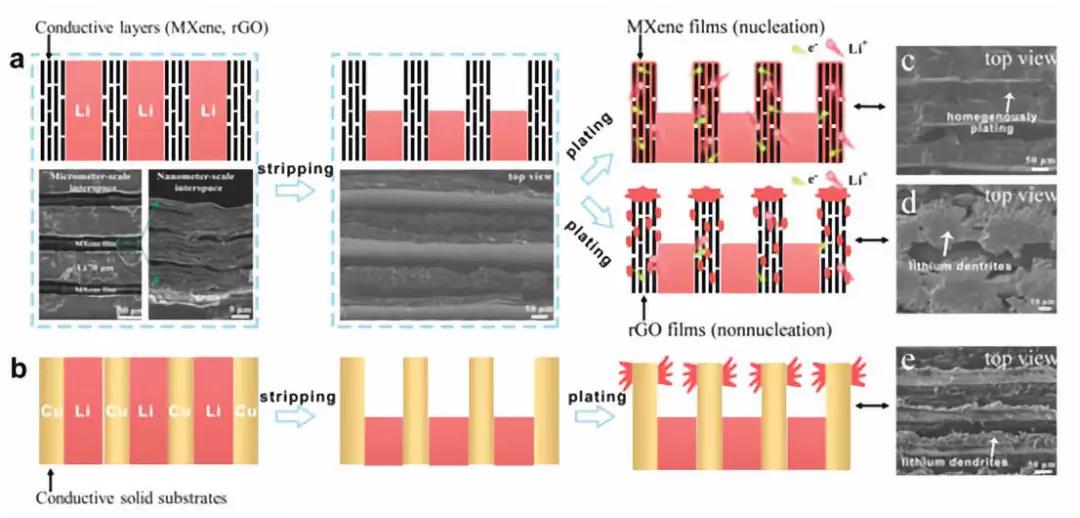
Figure 1. (a) Schematic of stripping and plating of vertical MXene-Li and rGO-Li arrays. The bottom left corner is a scanning electron microscopy image of the prepared vertical MXene-Li array showing micro-scale (70 μm) and nano-scale gaps. The middle bottom of (a) is a scanning electron microscope image of a vertical MXene-Li array after lithium stripping 20 mAh cm-2, showing the left gap between the MXene walls (b) vertical copper-lithium array stripping and plating (c) vertical MXene-Li array, (d) rGO-Li, (e) Cu-Li array does not exist on the vertical MXene-Li array after scanning electron microscopy after initial stripping of 20 mAh cm-2 and subsequent plating of 1 mAh cm-2 Lithium dendrites are quite different from the rGO-Li and Cu-Li anodes of massive lithium dendrites grown on top of rGO and Cu arrays.
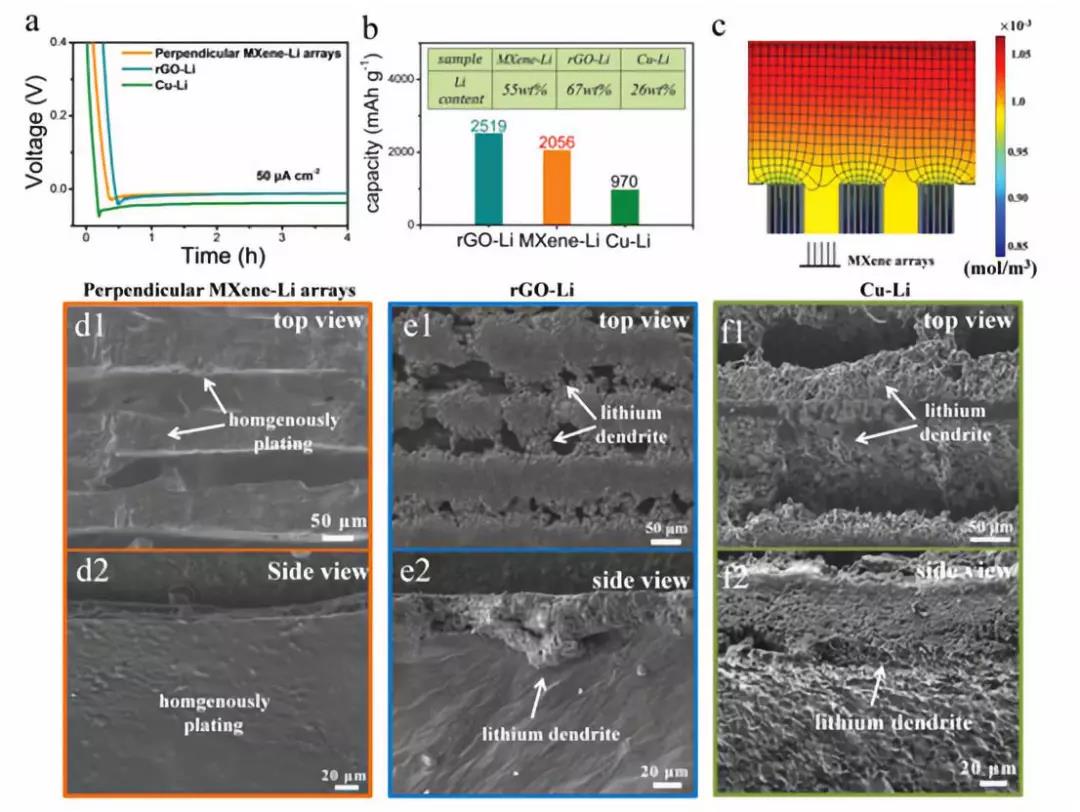
Figure 2. a) Compared to rGO-Li and Cu-Li arrays, the nucleation overpotential for lithium plating on vertical MXene-Li arrays is 23 mV, while the overpotential for vertical MXene-Li arrays is 23 mV b) vertical The specific capacity of the MXene-Li array has a high reversible capacity of 2056 mAh g-1 compared to the rGO-Li and Cu-Li arrays. Embedded in (b) is the Li level in MXene-Li, rGO-Li and Cu-Li anodes c) COMSOL multiple physical simulation of the concentration distribution of lithium ions in the vertical MXene-Li array in the plated state; MXene-Li array lithium-plated 1 mAh cm-2 d-(1) top view and d-(2) side-scan SEM image showing smooth surface; lithium-plated e-(1)e-(2) in rGO-Li array Scanning electron micrographs of lithium-plated f-(1)f-(2) on Cu-Li arrays show that a large number of lithium dendrites are grown on top of rGO and Cu arrays.
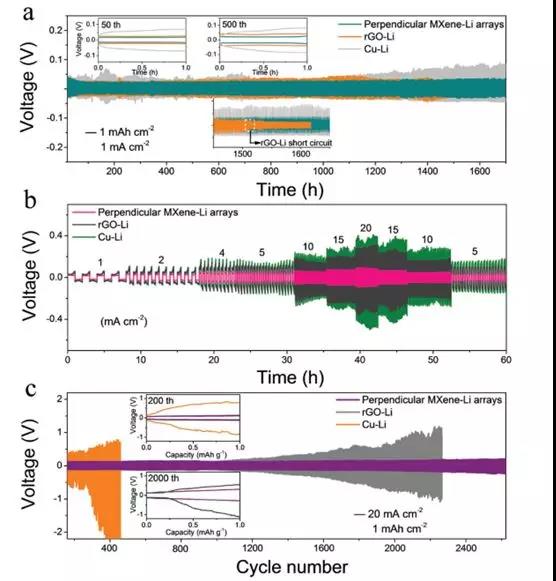
Figure 3. a) Cyclic performance of a symmetrical battery with vertical MXene-Li array, rGO-Li, and Cu-Li array at 1 mA cm-2, showing a long cycle life of up to 1600 h at 1 mA cm-2, lower than Potential 25 mV, better than rGO-Li and Cu-Li arrays b) Vertical MXene-Li array, rGO-Li and Cu-Li arrays at different current densities from 1 to 20 mA cm-2 c) Vertical MXene Cycle performance of the -Li array at high current densities of 20 mA cm-2, showing long life of up to 2,500 cycles
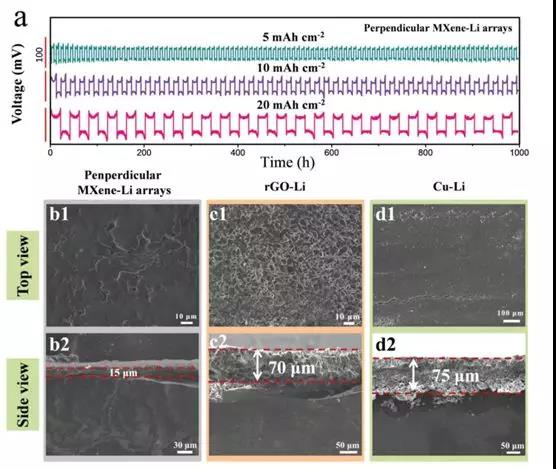
图4. a)在1.0 mA cm-2下,对于a)5,b)10和c)20 mAh cm-2,垂直MXene-Li阵列在不同深度剥离和电镀时的恒电流循环性能 b)电镀10 mAh cm-2后,垂直MXene-Li阵列的b-(1)b-(2)SEM图像,表明锂主要是电镀到MXene阵列中。电镀10 mAh cm-2后rGO-Li阵列的c-(1)c-(2)和Cu-Li阵列d-(1)和d-(2)的SEM图像, 表明由许多锂枝晶构成,显示出高达70–75 μm的厚锂层
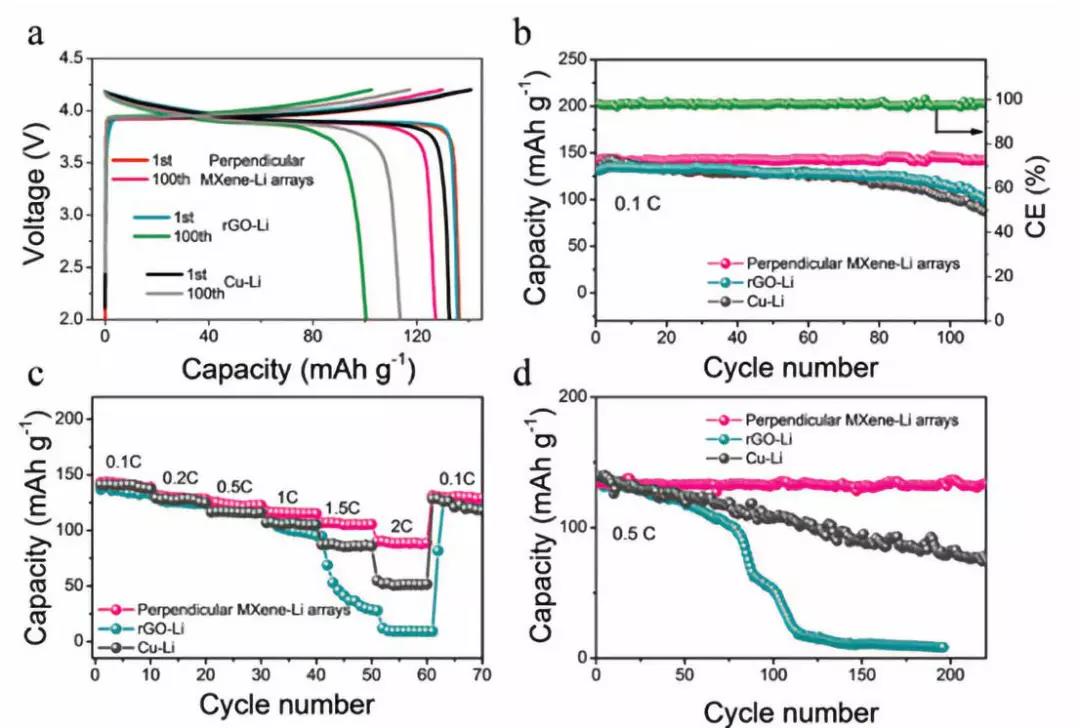
Figure 5. a) Voltage distribution of a full cell with a vertical MXene–Li array negative and LiCoO2 positive (mass load ≈17.6mg cm-2) compared to rGO-Li and Cu-Li negatives with the same positive electrode b The cycle performance of a full cell with a vertical MXene-Li array negative electrode at 0.1 C, showing good cycle stability c) Full cell with vertical MXene-Li array, rGO-Li and Cu-Li negative electrode at 0.1 to 2 Rate performance at different rates of C d) Cyclic stability with a vertical MXene-Li array, rGO-Li and Cu-Li anodes at 0.5 C.
[Summary of this article]
This paper implements a dendrite-free lithium anode of a vertical MXene-Li array with adjustable MXene walls and a constant spacing between them. This vertical MXene array has a double periodic gap in the MXene wall, ie a nanoscale gap, which is very advantageous for fast transport of lithium ions during insertion and deintercalation. The micron-sized MXene wall gap effectively equalizes the electric field and suppresses the lightning rod effect and volume change. This unique vertical MXene-Li array anode exhibits high specific capacity (2056 mAh g-1), long cycle life (1700h), good rate capability of up to 2500 cycles at 20 mA cm-2, and deep stripping and Electroplating capability of up to 20 mAh cm-2 provides new ideas for dendritic and high capacity lithium metal batteries.
Literature link:
Https://doi.org/10.1002/adfm.201908075
Source: WeChat public account MXene Frontier
- Previous: High performance MQW p
- Next: 1


 About us
About us